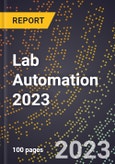Laboratory automation and informatics represent an important subset of the market for analytical instrumentation. Lab automation consists of a selection of technologies that reduce the manual labor that is required in repetitive laboratory procedures, or enable higher throughput R&D. High throughput analysis and increased productivity have been made possible by automated techniques, which can perform tasks at many times the speed of human technicians, and in a very reproducible manner which is improving quality. Likewise, software tools have accelerated analysis and enable rapid and accurate data transfer, analysis, and storage. Increasingly, laboratory-scale research involves partial or modular automation. These automation methods consist of automation of a single step in a given laboratory process or alternative hardware models that are designed to fit smaller laboratories. Consequently, these technologies serve to increase the efficiency, accuracy, and pace of work executed in various lab settings.
Lab automation encompasses an array of protocols, processes, and practices that can be performed with the use of technology. Usually, tasks that were performed manually are streamlined by using software, protocol specific consumables, instrumentation, and robotics. Most lab automation tasks are not truly walkaway; however, the latest technologies are employing algorithms along with hardware to enable innovation. The technologies used in lab automation include liquid handling, robotics, automated workstations, informatics, LIMS, and SaaS software. The market demand for sample management, autosamplers, and other automated manipulation are also explored.
Following a strong, post-pandemic recovery in 2022, demand for lab automation has slowed in 2023. Furthermore, the current macro-economic environment, including fluctuations in core inflation as well as costs of labor, energy, and goods sold have resulted in an additional layer of uncertainty. The effects of these developments are also outlined within The SDi Lab Automation Market Report, which incorporates a summary of recent market developments and dynamics that are shaping our view of the market, including recent business activities.
As the leading provider of market research on analytical instrumentation employed in industrial, life science, government, and pharmaceutical lab settings, SDi has crafted this report to evaluate the current drivers associated with this important market. The competitive situation for vendors participating in each lab scale automated technology category is investigated. The lab automation instrument market report classified lab automation technologies into eight different categories that represent the overall market covered in this report. Market demand is forecasted from 2022-2027 and further segmented by product type, end market, and region. In addition to market demand, vendors analysis and a competitive landscape are also estimated for the total lab automation market that consists of the following techniques:
- Liquid Handling
- Microplate Readers
- LIMS, ELN, SDMS
- Robotics
- Informatics
- Automatic Sampling & Imaging Stages
- Multiplex & HT ELISA
- Sample Management








